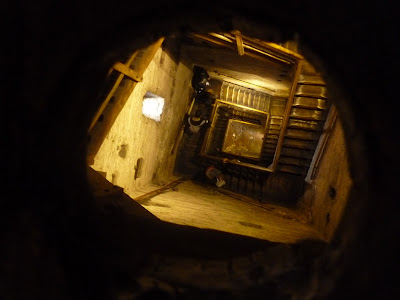
After our sodden first evening in Milan, we were delighted to wake up to a dry day the next morning. Clouds and smog were still sitting low on the rooftops, the city as normal, rather than at its best, but that was what we were there for: so that I could show Understanding Frenchman the city I lived in for a year, just as it really was.
We started out by walking from our hotel through the Giardini Pubblici, one of Milan's prettiest parks, to the Quadrilatero d'Oro, where all the designer flagship stores are. Other people might go there to buy luxury clothing, but we just got harassed by a dreadlocked bracelet-seller and enjoyed gazing at the window displays. We had planned to visit La Scala next, but a combination of the odd opening times of the museum and the fact that you could only see the auditorium from one small vantage point put us off, and we continued through the Gallerie Vittorio Emmanuele, pausing to wonder at the number of people who were spinning on their heels on the testicles of the bull in the floor design for luck. What immediately strikes you in this most ornate of shopping centres is the expensive shopfronts and the gilded arcades, but I happen to know because I've been there that overlooking the galleries are some very ordinary offices with people going about their everyday business inside.


After that we climbed the 200 or so steps up to the roof of the cathedral. A large part of it was unfortunately being refurbished, and the Alps were in hiding that day, but we did get a glimpse of the newest features on the Milanese skyline.
From the duomo, we walked over to the castle and strolled around the Parco Sempione, then took the side exit out to Cadorna station. I was hoping to baffle Understanding Frenchman with the riddle of my favourite sculpture in Milan, but that too was covered in scaffolding, so we jumped on the metro and headed out west so that I could show him the slightly scary street where I lived in a gorgeous apartment instead. It was lunch time, so the dodgy blokes, drug dealers and
carabinieri were all on their break and there wasn't much to see, so we took one of the ATM's middle aged (long and orange, with plastic seats) tram back to De Angeli for lunch. My favourite restaurant
there seemed to have closed but we managed to find some pasta and do some shopping.
In the afternoon, it was on to the Porta Genova for a walk along the Navigli (currently being drained and therefore with an even larger quantity of rubbish on show than normal, but the atmosphere is still there), then back up past the Roman columns to the centre again.
For dinner, I was excited to be taking Understanding Frenchman out for a
peritivo and the lively bar in the Brera that we found didn't disappoint. For nine euros, we each had a gorgeously adorned cocktail and about three plates of nibbles, which was probably more than enough to keep us going, but we couldn't resist an ice cream on the way home anyway.
And that was my tour of my old city. I don't think Understanding Frenchman was blown away by it all, but he did get a feel for the place, and I got to nosy round all my favourite haunts again, so it wasn't a wasted day.






























